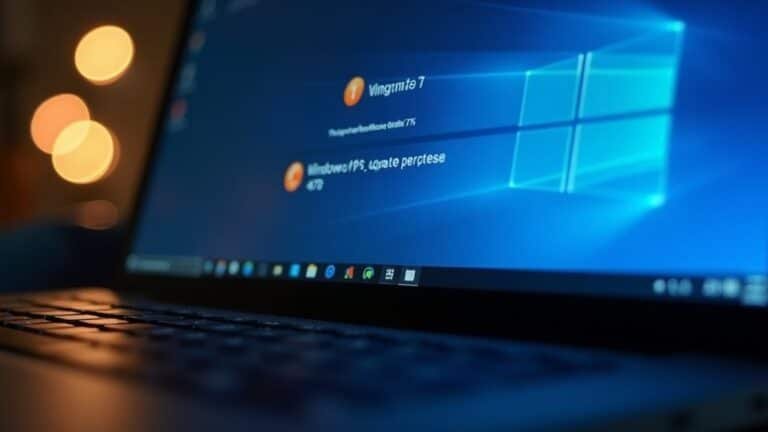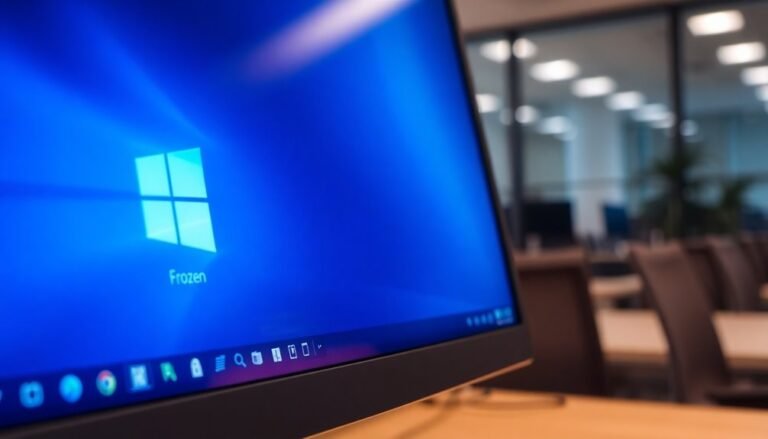Windows 11 Slow Internet: Fix Internet Connection Speed Issues
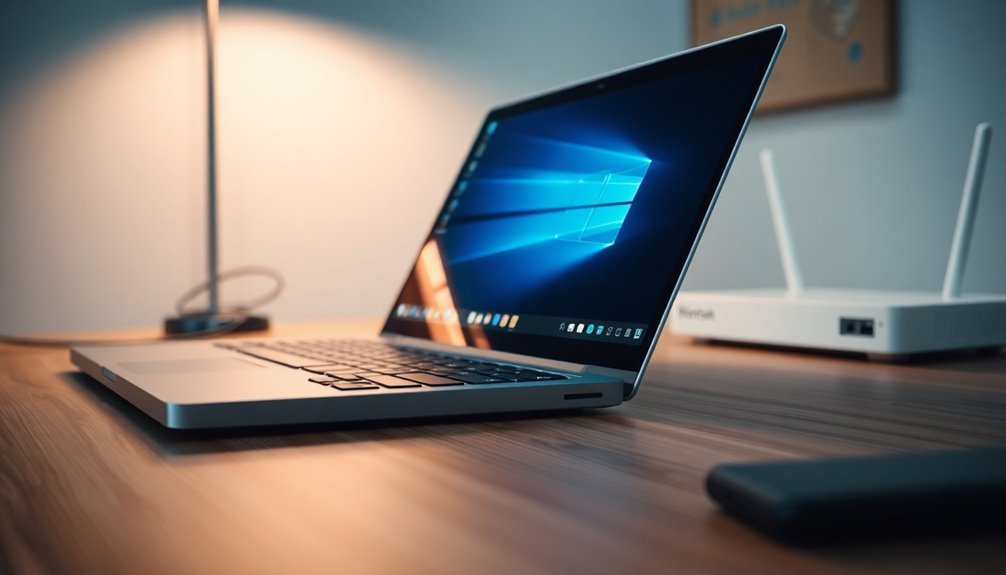
If your Windows 11 internet is slow, start by running the Network Troubleshooter and updating your network drivers. Outdated drivers or corrupt system files often choke your speed.
Disable metered connections and peer-to-peer update sharing. Optimize network adapter settings like Large Send Offload to remove bandwidth bottlenecks.
Switch to high-quality Ethernet cables or reposition your router for better Wi-Fi. Scan for malware and check for misconfigured DNS.
Fine-tuning these areas quickly reveals deeper ways to maximize your connection performance.
Common Causes of Slow Internet on Windows 11
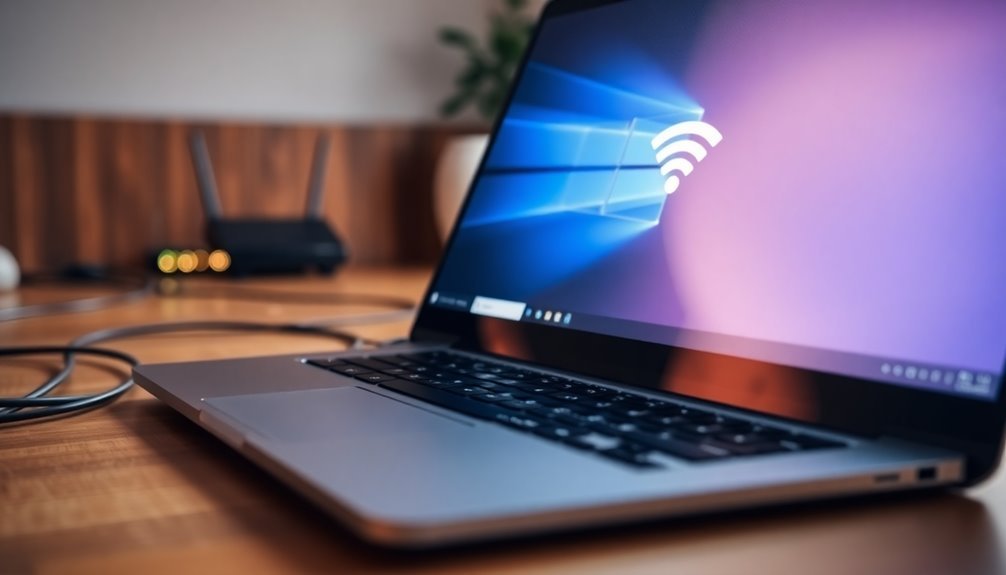
Common Causes of Slow Internet on Windows 11 and How to Fix Them
If you’re experiencing slow internet speeds on your Windows 11 PC, several common factors might be causing the issue. Slow internet on Windows 11 often results from system configuration problems, outdated network drivers, hardware limitations, or background processes consuming bandwidth.
Corrupt or missing system files can also reduce internet speed, so running file integrity checks and repairs is essential.
One frequent cause of slow internet on Windows 11 is the peer-to-peer update delivery system and background cloud sync services, which use bandwidth silently and affect overall network performance. Misconfigured internet settings or outdated network drivers can create bottlenecks.
To fix this, update or reinstall your network drivers using Device Manager or Windows Update to improve speed and stability.
Wi-Fi signal interference caused by physical obstacles, outdated routers, or using inferior Ethernet cables (such as Cat5 instead of Cat6) can also lead to slow internet on Windows 11. In addition to these hardware and configuration issues, Windows reserves 20% of bandwidth for updates and apps, which can impact your available connection speed if not adjusted.
Additionally, power-saving modes and incorrectly enabled metered connection settings may limit your network adapter’s performance, further slowing your connection.
To optimize internet speed on Windows 11, monitor active applications and disable unnecessary bandwidth-heavy features.
Regularly checking and adjusting these settings will help diagnose and resolve common internet speed issues, ensuring a faster and more reliable online experience.
Running the Windows Network Troubleshooter
How to Use the Windows Network Troubleshooter to Fix Slow Internet on Windows 11
Slow internet speeds on Windows 11 can be caused by a variety of issues, but the built-in Windows Network Troubleshooter provides an easy and effective way to diagnose and resolve common network problems.
To access the Network Troubleshooter, go to Start > Settings > Network & Internet > Status > Network troubleshooter, or simply type “Network Troubleshooter” into the Windows taskbar search box.
Once opened, the troubleshooter guides you through a step-by-step process to identify whether your connection is Wi-Fi or Ethernet and performs diagnostic tests on your network connectivity, IP settings, and hardware status.
It checks for valid local network access, proper IP address assignment, DNS server availability, and detects hardware issues such as disconnected cables or disabled network adapters.
The Network Troubleshooter can automatically fix many problems by renewing your IP address using the `ipconfig /renew` command, flushing the DNS cache, correcting proxy settings, and enabling DHCP if it’s disabled.
It may also recommend updating network drivers or resetting your network adapter to improve performance. The troubleshooter can also help you determine if your Wi-Fi adapter is enabled and functioning properly, which is a common cause of slow or missing internet connections.]
However, this tool can’t fix issues caused by your Internet Service Provider (ISP) or all driver and firmware problems.
If you continue to experience slow internet speeds after running the Windows Network Troubleshooter, review the detailed results and follow any suggested solutions.
For persistent network issues, consider using advanced troubleshooting methods or contacting your ISP for further assistance.
Disabling Features That Affect Internet Speed
How to Disable Windows 11 Features That Slow Down Your Internet Speed
If your internet speed feels slower than expected on Windows 11, certain built-in features might be limiting your bandwidth. Disabling these features can significantly improve your internet performance and optimize data throughput.
Follow these simple steps to boost your Windows 11 internet speed:
1. Turn Off Metered Connection
Go to Settings > Network & Internet > Wi-Fi or Ethernet > Properties and disable the Metered Connection option. This feature restricts data usage and can throttle your internet speed when enabled.
2. Disable Peer-to-Peer (P2P) Update Sharing
Navigate to Settings > Update & Security > Delivery Optimization and toggle off Allow downloads from other PCs. This stops Windows from using your bandwidth to download updates from or send updates to other computers.
3. Disable Windows Auto-Tuning
Open Command Prompt as an administrator and run the command:
`netsh int tcp set global autotuninglevel=disabled`
This fix helps resolve slowdowns caused by TCP receive window scaling issues.
4. Turn Off Large Send Offload (LSO)
In Device Manager, find your network adapter, open its properties, and disable Large Send Offload. This can fix throughput problems caused by incompatible network hardware.
5. Adjust QoS Packet Scheduler Settings
Use the Group Policy Editor to disable bandwidth reservation by QoS Packet Scheduler. This adjustment frees up more bandwidth for your active internet applications.
By following these tips to disable bandwidth-limiting features in Windows 11, you can enhance your internet speed and enjoy a smoother online experience.
For more Windows 11 optimization guides, stay tuned to our tech tutorials.
Updating and Reinstalling Network Drivers
How to Fix Internet Slowdowns on Windows 11 by Updating and Reinstalling Network Drivers
Experiencing slow internet speeds on Windows 11? One common cause is outdated, incompatible, or corrupted network drivers that lead to connectivity issues and inconsistent speeds.
To resolve this, start by opening Device Manager from the Start menu. Expand the “Network adapters” section to find your exact network adapter model.
To update your network drivers automatically, right-click your adapter, select “Update driver,” and then choose “Search automatically for updated driver software.” Windows 11 will search online and install the latest driver if available.
If Windows Update doesn’t find the newest or most compatible driver, manually download it from your network adapter manufacturer’s official website. Then, select “Browse my computer for drivers” in Device Manager and point to the downloaded driver file.
If updating doesn’t fix the internet slowdown, uninstall the network driver from Device Manager and restart your PC. Windows 11 will automatically reinstall a default driver, which can fix driver corruption issues.
After rebooting, consider updating the driver again manually or using the manufacturer’s dedicated update tool for the best performance.
Always download drivers from official manufacturer sources to ensure compatibility, enhance network stability, and protect your system from security risks.
Regularly updating and reinstalling your Windows 11 network drivers is a proven method to improve internet speed and maintain a stable connection.
Optimizing Network Adapter and Hardware Settings

Optimize your Windows 11 internet speed and stability by fine-tuning your network adapter and hardware settings.
First, update your network drivers regularly to ensure peak performance. Then, increase your network adapter’s Receive and Transmit Buffers, along with Receive Descriptors, through Device Manager’s Advanced settings. Maximize these values if your system has enough RAM, but be mindful of potential memory limits.
Disable power-saving features like Energy Efficient Ethernet, PowerDownPll, and Idle Power Down Restriction to prevent your network adapter from entering latency-causing sleep states.
Enhance real-time network responsiveness by turning off Large Send Offload (LSO), Large Receive Offload (LRO), Receive Segment Coalescing (RSC), Interrupt Moderation, and Flow Control.
Set your network adapter speed to a fixed 1 Gbps Full Duplex or the highest supported speed, and always use high-quality Ethernet cables for optimal connectivity.
Finally, boost your browsing speed by switching to reliable public DNS servers such as Google DNS (8.8.8.8) or Cloudflare DNS (1.1.1.1).
Follow these expert tips to maximize your Windows 11 network performance and enjoy faster, more stable internet connections.
Repairing System Files and Removing Malware
How to Fix Slow Internet on Windows 11 by Repairing System Files and Removing Malware
If you’re experiencing slow internet speeds on Windows 11, one effective solution is to repair corrupted system files and remove malware that might be affecting your network performance.
Start by running the Deployment Image Servicing and Management (DISM) tool. Open an elevated Command Prompt and type the command: `DISM /Online /Cleanup-Image /RestoreHealth`. This process repairs the Windows image to ensure system stability.
After DISM completes, run the System File Checker by entering `sfc /scannow` to detect and fix corrupted or missing system files that could be slowing down your internet connection.
In cases where the System File Checker can’t resolve all issues, DISM ensures that necessary repair files are available, minimizing the need for a complete Windows reinstall.
Additionally, performing a full malware scan with Windows Defender or trusted third-party anti-malware software is crucial to eliminate viruses or unwanted programs that consume bandwidth or disrupt network drivers. Regular malware scans help maintain optimal internet speed by removing background threats.
For ongoing slow internet problems, consider performing a repair install through Windows 11 Settings: go to System > Recovery and select the repair option to restore system integrity without losing your files or apps.
Following these steps can significantly improve your Windows 11 internet speed and overall network reliability.
Tweaking Advanced Network Settings for Performance
How to Fix Slow Internet on Windows 11 by Tweaking Advanced Network Settings
If you’re experiencing slow internet on Windows 11 despite repairing system files and removing malware, the issue might be due to advanced network adapter or protocol settings. To boost your internet speed, start by disabling Large Send Offload (LSO) and Receive Side Scaling (RSS) in your Network Adapter’s Advanced tab.
These features can cause instability and high CPU usage during heavy network traffic. Make sure to disable both IPv4 and IPv6 versions of LSO for better compatibility.
Next, optimize your TCP settings by checking TCP Auto-Tuning status with the command `netsh interface tcp show global`. Adjust it to “normal” for balanced network performance or disable it if you notice inconsistent speeds.
Implement Quality of Service (QoS) policies through Group Policy or your network adapter settings to prioritize bandwidth for latency-sensitive applications and reduce buffer bloat.
Additionally, modify your network adapter’s power management settings by setting Transmit Power to maximum and disabling power-saving options like PowerDownPll. This helps maintain stable internet speeds.
Finally, increase your adapter’s transmit buffers, disable segment coalescing, and keep the VLAN ID set to zero unless your network requires otherwise. These tweaks ensure smoother data flow and lower latency on Windows 11.
Improving Wi-Fi Signal and Reducing Interference
Boost Your Windows 11 Wi-Fi Signal Strength and Reduce Interference for Faster, Stable Connections
If your Windows 11 device experiences weak or inconsistent Wi-Fi, improving signal strength and minimizing interference is essential for a fast and reliable internet connection. To optimize your Wi-Fi performance, position your router in a central, elevated location away from metal objects, concrete walls, and electronic devices that can disrupt the signal.
Avoid placing your router inside cabinets or enclosed spaces, and ensure there are minimal dense walls between your router and connected devices.
For larger homes or areas with poor coverage, consider using wireless repeaters or Wi-Fi extenders. Install these devices midway between your router and low-signal zones to maximize coverage without causing network slowdowns. Choose high-quality extenders to maintain strong performance.
Use Wi-Fi analyzer tools to check for channel congestion in your area. Switch your router’s 2.4 GHz band to channels 1, 6, or 11, which are less likely to overlap, or use the 5 GHz band to reduce interference and improve speeds.
Upgrade weak internal Wi-Fi adapters to USB adapters with external antennas for better reception on your Windows 11 device. Additionally, keep your router firmware and Wi-Fi adapter drivers updated regularly. Always reboot your router after firmware updates to ensure all enhancements take effect.
Monitoring and Managing Network Traffic
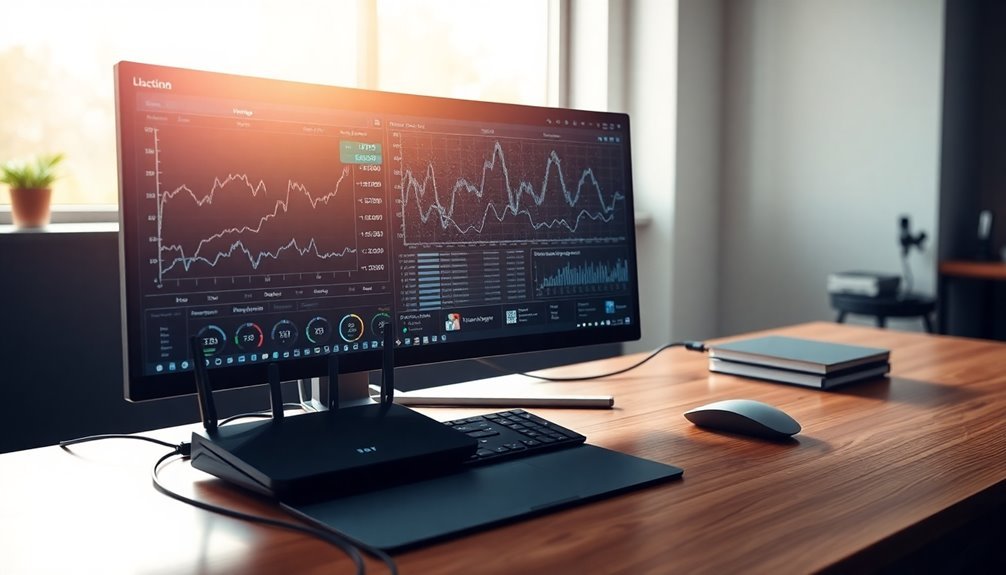
Boost Your Windows 11 Network Speed by Monitoring and Managing Traffic Effectively
If you’re experiencing slow Wi-Fi on Windows 11 despite boosting your signal, the issue often lies in unmanaged network traffic or bandwidth-hogging applications. To improve your network performance, use built-in tools like Resource Monitor (resmon) for real-time monitoring of app-specific network usage and latency.
Simply press Win+R, type “resmon,” and access detailed insights to identify problematic applications.
For more advanced network analysis, Microsoft Network Monitor 3.4 is a powerful option. Keep in mind that installing its driver may cause a brief network interruption. Start a capture session, reproduce the slowdown, then stop and analyze the .cap file by filtering protocols, IP addresses, or processes to pinpoint network anomalies.
For granular control and visual bandwidth analytics, popular third-party tools like Wireshark and GlassWire are highly recommended.
Enterprise users can benefit from deploying PRTG Network Monitor, which offers SNMP-based device discovery and customizable sensor monitoring to continuously track network traffic.
Regularly monitoring your network traffic, cross-referencing data with netstat or Task Manager, and aggressive filtering will help you quickly spot bandwidth hogs, rogue apps, or abnormal traffic patterns slowing down your Windows 11 connection.
Implement these network traffic management strategies today to optimize your Windows 11 internet speed and enhance overall connectivity.
Frequently Asked Questions
Can Third-Party Antivirus Software Slow Down My Internet on Windows 11?
Yes, third-party antivirus software can throttle your internet speed on Windows 11. You’ll notice slowdowns from real-time traffic scanning, packet inspection, and resource-heavy background processes. Analyze Task Manager and antivirus settings to isolate and mitigate these performance impacts.
Does Using a VPN Always Reduce Internet Speed on Windows 11?
Yes, using a VPN almost always reduces your internet speed on Windows 11—you add encryption, re-route traffic, and face potential driver conflicts. Test different VPN protocols, update network drivers, and disable Windows Auto-Tuning to optimize throughput.
Will Upgrading My RAM Improve My Internet Speed?
Upgrading your RAM won’t directly increase your internet speed since bandwidth depends on your network hardware and ISP. However, you’ll see better multitasking, browser responsiveness, and streaming if your system was previously limited by insufficient memory.
Can Browser Extensions Affect Download and Upload Speeds?
About 51% of browser extensions measurably increase page load times, so yes, you’ll see slower download and upload speeds. Analyze active extensions, especially those running background tasks, and systematically disable them to isolate performance bottlenecks and restore peak throughput.
Does Windows 11 Home and Pro Handle Network Speed Differently?
You won’t see any difference in core network speed between Windows 11 Home and Pro. Both editions leverage the same network stack, drivers, and throughput limits, so network performance depends on hardware and configuration, not the OS edition.
Conclusion
If your Windows 11 internet feels like it’s wading through molasses, you’ve now got the toolkit to clear the path. By deploying diagnostics, pruning unnecessary features, updating drivers, and fine-tuning hardware, you eliminate digital roadblocks. Scrubbing system files and keeping malware at bay guarantees nothing lurks in the shadows. With these analytical steps, you’ll transform sluggish networks into streamlined expressways—guaranteeing your data traffic flows smoothly without unexpected detours or speed bumps.

